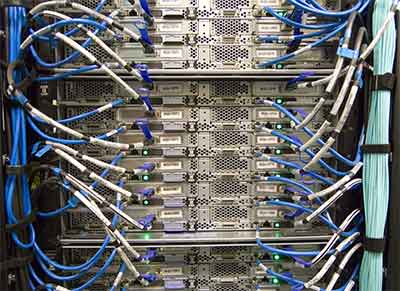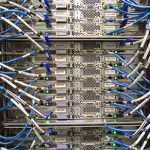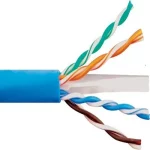One of the most crucial aspects of data transmission in computer networks is the understanding of how signal strength diminishes or gets lost over the course of transmission, more commonly referred to as “signal loss”. This phenomenon affects all types of communication cables, including Ethernet cables like Cat6 and Fiber Optic cables. Let’s check the details of signal loss for these two primary types of cables, as well as other prevalent communication cables.
1. Cat6 Cables
Category 6 (Cat6) cables are standard for Gigabit Ethernet and other network protocols that are backward compatible with the Category 5/5e and Category 3 cable standards. Cat6 cables provide performance up to 250 MHz.
Signal Loss in Cat6 Cables
The signal loss, also known as attenuation, in Cat6 Cabling is primarily influenced by the length of the cable. It increases linearly as the distance of the transmission expands. After approximately 100 meters (328 feet), Cat6 cables tend to experience significant signal loss, resulting in diminished data transmission rates. This is why Ethernet connections, in general, are typically limited to this distance for reliable data transmission.
Crosstalk is another contributing factor to signal loss in Cat6 cables. Crosstalk occurs when an electrical signal from one cable interferes with another, causing noise and signal disruptions. However, Cat6 cables are designed with more stringent specifications for crosstalk and system noise than Cat5 and Cat5e cables, thereby reducing the effect of these disturbances.
2. Fiber Optic Cables
Fiber optic cables are an advanced type of network cable, providing extremely fast data transmission rates over much longer distances compared to traditional copper cables like Cat6.
Signal Loss in Fiber Optic Cables
Signal loss in fiber optic cables, often referred to as fiber attenuation, is quite different from that in Cat6 cables. The primary cause of signal loss in fiber optic cables is the absorption of light (used to transmit data) by the cable’s glass core. Other causes include scattering due to cable impurities and physical stress on the cable.
The rate of signal loss in fiber optic cables is measured in decibels per kilometer (dB/km) and is generally much lower than that in copper cables, allowing for transmissions over much greater distances. Depending on the type of fiber (single mode or multi-mode) and the light wavelength used, this could be as low as 0.2 dB/km, meaning high-speed data can be reliably transmitted over tens of kilometers without the need for signal boosting.
There are two primary types of fiber optic cables used for different purposes: multimode and single-mode. Both types experience signal loss, known as attenuation, but how this occurs and the extent of the loss varies between them.
Single-Mode Fiber Optic Cables
Single-mode fiber (SMF) optic cables contain a single optical fiber with a small core (usually 9 micrometers in diameter). This allows only a single light path or “mode” to pass through the fiber, reducing distortion and retaining signal quality over long distances.
Signal Loss in Single-Mode Fiber
The primary sources of signal loss in single-mode fiber optic cables are scattering, absorption, and bending.
- Scattering is caused by minute imperfections in the fiber optic glass, causing a small fraction of light to be scattered in directions other than the intended path.
- Absorption is caused by the fiber optic material itself and impurities within it, which absorb a portion of the light signal.
- Bending or microbending losses happen due to small-scale deformities in the fiber or macrobending losses due to larger-scale bends beyond the cable’s specified bend radius.
The loss in single-mode fiber optic cables is often lower than in multimode cables and allows for transmission over much greater distances. Signal loss is typically around 0.35 dB/km at 1310nm wavelength and around 0.25 dB/km at 1550nm wavelength.
Multimode Fiber Optic Cables
Multimode fiber optic cables, in contrast, have a much larger core diameter (usually 50 or 62.5 micrometers) which allows multiple light paths or “modes” to propagate within the fiber. This results in more data capacity but over shorter distances due to modal dispersion.
Signal Loss in Multimode Fiber
Signal loss in multimode fiber optic cables is caused by the same factors as in single-mode fibers (scattering, absorption, bending), but with the additional factor of modal dispersion.
- Modal dispersion occurs when light travels down the multiple paths or “modes” within the fiber at different speeds, causing the light pulses to spread out, arrive at different times at the receiving end, and thus reducing the quality of the signal. This is the primary reason why multimode fibers are limited to shorter distances compared to single-mode fibers.
The signal loss in multimode fibers is typically higher than in single-mode fibers. Depending on the specific type of multimode fiber (OM1, OM2, OM3, OM4), the loss can range from about 3.5 dB/km to 1.5 dB/km at 850nm wavelength.
While both single-mode and multimode fiber optic cables experience signal loss, the reasons for the loss and the distance over which they can reliably transmit data vary. Single-mode fibers can transmit data over greater distances with less signal loss, making them ideal for long-distance telecommunication networks. In contrast, multimode fibers offer high data capacity over shorter distances, making them suitable for data communications in local area networks where high bandwidth is crucial, and the transmission distance is relatively short.
3. Other Types of Communication Cables
Coaxial Cables
Coaxial cables, often used in TV and internet connections, also experience signal loss over distance. Similar to Cat6 cables, this attenuation increases linearly with distance. Coaxial cables are shielded, which helps reduce signal loss from electromagnetic interference.
Cat7 and Cat8 Cables
Cat7 and Cat8 cables are higher-performance variants of Ethernet cables. They experience signal loss similarly to Cat6, with the distance of reliable data transmission being roughly 100 meters. However, due to their more advanced design and shielding, they can handle higher bandwidths and frequencies, reducing the effect of crosstalk and thus potentially offering improved performance over Cat6.
In summary, signal loss is a fundamental factor that must be considered when designing or implementing any form of data transmission network. Understanding the specifics of each cable type helps make more informed decisions, leading to networks that offer both reliable and efficient performance.





